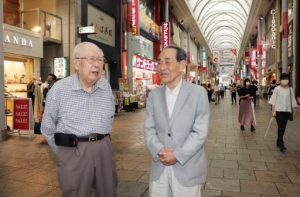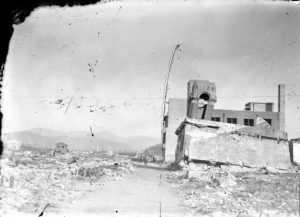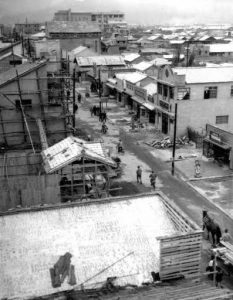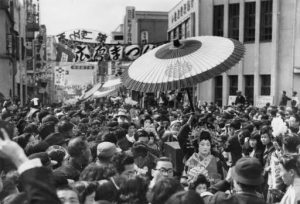Hondori recovered from atomic bombing after surviving store owners’ great efforts and festival attracted customers
Jul. 14, 2020
by Minami Yamashita, Staff Writer
This year marks 90 years since the Hondori shopping street (Naka Ward), extending east to west in downtown Hiroshima, took on the name “Hondori.” The entire neighborhood along the street, from roughly several tens of meters to 700 meters from the hypocenter, was burned to the ground 75 years ago on August 6. Many shops lost owners and entire families in the atomic bombing. With the strenuous efforts of surviving store owners, however, the street was revived, until today the area is bustling with shoppers. Herein, we will look back at the development and changes that took place for the Hondori shopping street during the postwar reconstruction period.
People come and go on foot or by bicycle in front of shops with signs that read “American Shop” or “Meidi-Ya.” The photograph in question was taken in 1948, three years after the atomic bombing. While many store owners gave up rebuilding their shops on the Hondori shopping street, which was annihilated in the atomic bombing, the photo speaks to the atmosphere of the occupation period during which the reconstruction of the area was underway.
“Hondori was lined with stores by the time I returned here at the end of 1950,” said Hiroshi Okumoto, 90, Naka Ward. He still lives in the Hondori area, where he was born and raised. His family ran a hardware shop in former Harimaya-cho, but the shop where he was born was burned down in the bombing. He lost six family members including his parents and brothers and sisters. After the bombing, he and his surviving grandmother stayed with relatives in Kagawa Prefecture for several years.
The late Ryoichi Nakayama, who once managed a musical instrument store, took the lead in the “rebirth” of the Hondori shopping street. According to the History of the Hiroshima Hondori Shopping Arcade, compiled by the Hiroshima Hondori Shopping District Promotion Association, Mr. Nakayama located the whereabouts of the surviving store owners by checking a register of former Harimaya-cho residents, which had been kept at another location and thereby escaped the fires, holding a meeting with them in September 1945. In 1946, he started a reconstruction founders’ council.
Although the Housing Control Association built ten barrack-like structures with a six-tatami room, a kitchen and retail space, much of the land was still vacant. Mr. Nakayama and other members, therefore, built mobile one-tatami room shops to encourage people who wanted to open stores to move there, with the aim of making the street livelier.
Several difficulties arose, however, such as shoppers being tempted by the black market in front of Hiroshima Station. Hiroshi Noda, 89, Nishi Ward, former head of the association, said, “I think store owners in Hondori were proud of their products because they were superior in quality to those sold in the black market.” At the end of 1946, they held a special sale with a lottery drawing for the first time since conclusion of World War II.
Mr. Noda lived on the Hondori shopping street until the Sino-Japanese War began. In 1950, he started to work at a kimono fabrics shop along the street. In 1952, a Hiroshima festival was begun, in which costumed people paraded through the Hondori shopping street. More and more people were gradually attracted to the arcade. Later, Mr. Okumoto and Mr. Noda each opened a men’s clothing store on the Hondori shopping street.
“Right after the war, I couldn’t have imagined that Hondori would become this popular,” Mr. Noda said. Recently, he said he feels sad seeing privately run stores standing side by side being replaced by chain stores selling mass-produced goods in volume. “I hope it can become a more attractive street with unique stores that can only be found here.” We also hope that the area revived from burned ruins continues to be a center of activity and a symbol of recovery.
(Originally published on July 14, 2020)
This year marks 90 years since the Hondori shopping street (Naka Ward), extending east to west in downtown Hiroshima, took on the name “Hondori.” The entire neighborhood along the street, from roughly several tens of meters to 700 meters from the hypocenter, was burned to the ground 75 years ago on August 6. Many shops lost owners and entire families in the atomic bombing. With the strenuous efforts of surviving store owners, however, the street was revived, until today the area is bustling with shoppers. Herein, we will look back at the development and changes that took place for the Hondori shopping street during the postwar reconstruction period.
People come and go on foot or by bicycle in front of shops with signs that read “American Shop” or “Meidi-Ya.” The photograph in question was taken in 1948, three years after the atomic bombing. While many store owners gave up rebuilding their shops on the Hondori shopping street, which was annihilated in the atomic bombing, the photo speaks to the atmosphere of the occupation period during which the reconstruction of the area was underway.
“Hondori was lined with stores by the time I returned here at the end of 1950,” said Hiroshi Okumoto, 90, Naka Ward. He still lives in the Hondori area, where he was born and raised. His family ran a hardware shop in former Harimaya-cho, but the shop where he was born was burned down in the bombing. He lost six family members including his parents and brothers and sisters. After the bombing, he and his surviving grandmother stayed with relatives in Kagawa Prefecture for several years.
The late Ryoichi Nakayama, who once managed a musical instrument store, took the lead in the “rebirth” of the Hondori shopping street. According to the History of the Hiroshima Hondori Shopping Arcade, compiled by the Hiroshima Hondori Shopping District Promotion Association, Mr. Nakayama located the whereabouts of the surviving store owners by checking a register of former Harimaya-cho residents, which had been kept at another location and thereby escaped the fires, holding a meeting with them in September 1945. In 1946, he started a reconstruction founders’ council.
Although the Housing Control Association built ten barrack-like structures with a six-tatami room, a kitchen and retail space, much of the land was still vacant. Mr. Nakayama and other members, therefore, built mobile one-tatami room shops to encourage people who wanted to open stores to move there, with the aim of making the street livelier.
Several difficulties arose, however, such as shoppers being tempted by the black market in front of Hiroshima Station. Hiroshi Noda, 89, Nishi Ward, former head of the association, said, “I think store owners in Hondori were proud of their products because they were superior in quality to those sold in the black market.” At the end of 1946, they held a special sale with a lottery drawing for the first time since conclusion of World War II.
Mr. Noda lived on the Hondori shopping street until the Sino-Japanese War began. In 1950, he started to work at a kimono fabrics shop along the street. In 1952, a Hiroshima festival was begun, in which costumed people paraded through the Hondori shopping street. More and more people were gradually attracted to the arcade. Later, Mr. Okumoto and Mr. Noda each opened a men’s clothing store on the Hondori shopping street.
“Right after the war, I couldn’t have imagined that Hondori would become this popular,” Mr. Noda said. Recently, he said he feels sad seeing privately run stores standing side by side being replaced by chain stores selling mass-produced goods in volume. “I hope it can become a more attractive street with unique stores that can only be found here.” We also hope that the area revived from burned ruins continues to be a center of activity and a symbol of recovery.
(Originally published on July 14, 2020)












